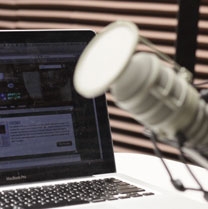Grant Spotlight | August 1, 2012
Share This |
Recipient Grant |
Contact Website: Watch now: |
||
How does a field that once considered cassette tapes and transcripts "high tech" transition into the 21st century? The collection and preservation of oral history is changing, and it is the goal of a team from Michigan State University (MSU) to define how oral history can not only survive in today’s digital, networked, and multimedia-rich world, but thrive.
The idea for the "Oral History in the Digital Age" project was born out of MATRIX, a humanities computing center at MSU devoted to the application of new technologies for teaching, research, and outreach. The concept was a natural outgrowth of the center’s activities, which include maintaining online resources and creating forums for knowledge exchange. According to MATRIX Director Dean Rehberger, "We’ve had a longstanding interest in oral history and the spoken word."
Indeed, MATRIX houses major digital library repositories, such as the African Online Digital Library; Detroit Public Television’s American Black Journal video archives; Historical Voices, a searchable online database of spoken word collections spanning the 20th century; and The Quilt Index. MATRIX is home to everything from a major Studs Terkel collection to a collection of oral narratives in African languages that are disappearing.
MATRIX faculty member and research professor Steve Cohen came up with the idea for the project, which was to marshal resources and combine expertise to advance seven core issues for oral history in the digital age: intellectual property, transcriptions, digital video, technology, scholarship, preservation, and access/interfaces. When identifying these core issues, "We realized we had to think along the whole chain, from collecting to curating to disseminating," says Rehberger. "We had to include legal and copyright issues."
A veritable dream team of top experts in fields such as information studies, audio preservation, law, history, and communicative sciences was amassed to oversee collaborative working groups in each of the seven areas. Dr. Doug Boyd, Director of the Louie B. Nunn Center for Oral History at the University of Kentucky, handled the day-to-day management of the project.
One of the five stated goals of the effort was to develop standards for video-based oral histories. "We had a good grasp on what to do with audio – those standards were set," says Rehberger. "The video standards, however, are really up in the air. We wanted to address this problem from the technical side, and develop the best practices for video."
In the past, continues Rehberger, "The transcript was always king. You did a transcription and then threw away the original video. Digital recording has changed that. Now, video recording has become easier."
While the transition into a digital world has brought new affordability, flexibility, and accessibility to the field, it has also brought fresh challenges. Questions arise about the use of digital video, the need for unified standards of practice, and intellectual property rights. Technical challenges also remain. "How can we get the people who make video histories follow certain standards so that their work can be better used by archives, museums, and other end users?" says Rehberger, articulating a question that drove the project. "Can we make the product better on the front end so it’s more useful on the back end?"
The "Oral History in the Digital Age" website (http://ohda.matrix.msu.edu) is part of the answer. This centerpiece of the project is home to more than 70 "micro-essays" by experts in the field that cover topics ranging from selecting video equipment and achieving good audio recording levels to intellectual property issues and oral history podcasts. Rehberger’s goal with the micro-essays is to create a repository of information that constantly grows and changes. "The technology just keeps moving on us, so we’re encouraging our contributors to edit their essays as needed," he says. "This is a resource that Doug and I are committed to keeping updated. This is not by any means the final product."
A highlight of the website is the "Thinking Big" video series, which features videos of leading voices in digital oral history and digital media. Automatic Speech Recognition, field recording in the digital age, and oral history and emerging technologies are just some of the timely topics discussed.
"We shifted some of our funding to do the videos," explains Rehberger. "It wasn’t part of the original grant, but we got permission from IMLS to do it."
The site also features case studies on collecting, curating and disseminating, an interactive "Ask Doug" feature (starring Doug Boyd) that helps visitors find the right equipment for a project, a helpful glossary, and numerous other resources that address nearly every aspect of preserving oral history in the digital age. Website content intentionally covers not just oral history but oral narrative, because "a folklorist and an oral historian think about the whole process in different ways," explains Rehberger.
As for developing a set of best practices for oral histories in video form, that goal is still evolving. "It would have been nice to have come out and said, ‘here’s the final answer,’" says Rehberger. "But life is more complex than that."
Beyond the website, there will be a special issue of The Oral History Review, the official publication of the Oral History Association. A social media blitz and promotion on H-Net – the international scholarly networking community hosted by MATRIX – will happen during the website’s official launch and again in September, when university communities start to hum again.
"We’re also thinking about doing an e-book for people who want to teach about oral history in the digital age as part of a curriculum," says Rehberger.
The response to the project has been overwhelmingly positive. "For the Heritage Preservation Association we did a webinar reprise of our WebWise presentation, ‘Digital Voices: Preserving Oral History Collections,’" says Rehberger. "A turnout of 40 is great for these webinars, and 60 is a lot. We had 130 people sign on! So far, the feedback’s been really positive."
Rehberger applauds the "great people" from the project’s partners, whose contributions were invaluable. In addition to MATRIX, partners include the Michigan State University Museum, the American Folklife Center at the Library of Congress, the Smithsonian Center for Folklife and Cultural Heritage, the American Folklore Society, and the Oral History Association.
"The IMLS support has been fantastic," adds Rehberger. "The nice thing about IMLS is they don’t just say, ‘here’s the money, go do your thing.’ They support you along the way."
For Rehberger, however, the best part of the project is working with oral historians and folklorists. "They are the nicest people you’ll ever meet," he says.

